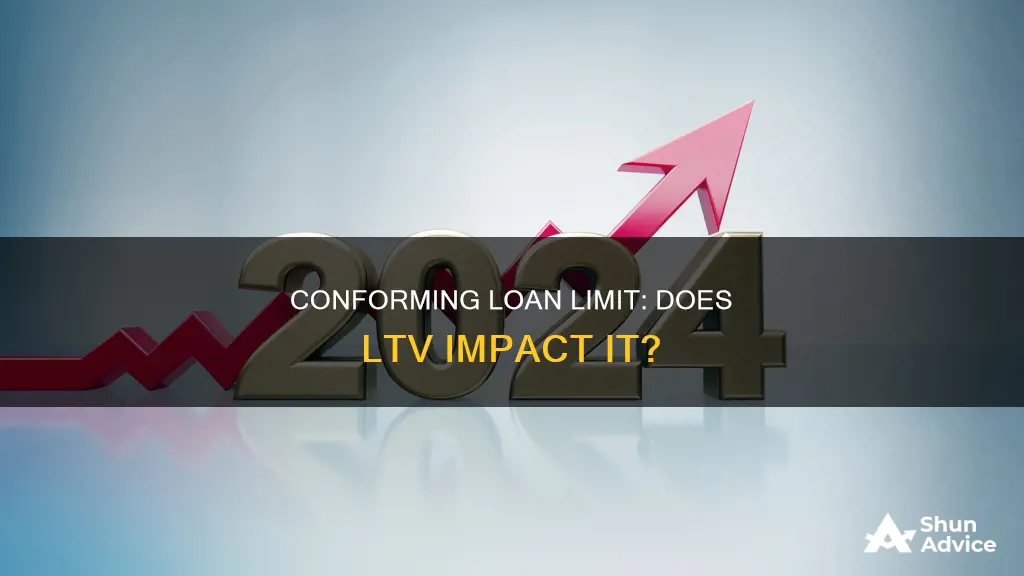
Conforming loans are mortgages that meet the criteria set by the Federal Housing Finance Agency (FHFA) and the funding criteria of Freddie Mac and Fannie Mae. The conforming loan limit is the dollar cap on the size of a mortgage that Freddie Mac and Fannie Mae will purchase or guarantee. The conforming loan limit is adjusted annually in November to reflect changes in the housing market. The conforming loan limit varies by county and is based on regional economic differences. The loan-to-value (LTV) ratio is an assessment of lending risk that financial institutions and other lenders examine before approving a mortgage. A higher LTV ratio is considered a higher-risk loan and may require the borrower to purchase mortgage insurance. So, does the conforming loan limit vary by LTV?
| Characteristics | Values |
|---|---|
| What is a conforming loan? | A mortgage that meets the criteria set by the Federal Housing Finance Agency (FHFA) and the funding criteria of Freddie Mac and Fannie Mae. |
| What is the conforming loan limit? | The dollar cap on the size of a mortgage that Freddie Mac and Fannie Mae will purchase or guarantee. |
| Who sets the conforming loan limit? | The Federal Housing Finance Agency (FHFA) |
| How often is the conforming loan limit set? | Annually, in November |
| What is the basis for setting the conforming loan limit? | The October-to-October percentage increase/decrease in the average house price, as indicated in the House Price Index report issued by the Federal Housing Finance Board (FHFB) |
| What is the conforming loan limit for 2025? | $806,500 for a single-family home in most markets, but up to $1,209,750 in higher-cost areas |
| What is a non-conforming loan? | A mortgage that exceeds the conforming loan limit |
| What is a Loan-to-Value (LTV) ratio? | An assessment of lending risk that financial institutions and other lenders examine before approving a mortgage |
| What is a good LTV ratio? | A good LTV hovers around 80% or less |
| How does the LTV ratio impact the interest rate? | A higher LTV ratio leads to a higher interest rate |
| How does the LTV ratio impact the down payment? | A higher down payment results in a lower LTV ratio |
What You'll Learn

Conforming loan limits are set annually by the FHFA
Conforming loans are mortgages that meet the criteria set by the Federal Housing Finance Agency (FHFA). The FHFA sets the conforming loan limit annually, usually in November, to reflect changes in the average price of a home in the United States. The FHFA uses the October-to-October percentage change in the average house price to adjust the loan limit for the subsequent year. This ensures that the loan limits are in line with the current real estate market, allowing buyers continued access to conforming mortgages.
The conforming loan limit is the maximum amount that the Federal National Mortgage Association (Fannie Mae) and the Federal Home Loan Mortgage Corporation (Freddie Mac) will purchase or guarantee. These government-sponsored enterprises (GSEs) are the principal market makers in mortgages, and their funding criteria must be met for a loan to be considered a conforming loan. Conforming loans have several advantages, including lower interest rates and a wider range of lenders.
The conforming loan limit is set nationally by the FHFA, but it can vary at the county level based on regional economic differences. Counties can adjust the limit up or down, resulting in higher limits in areas with higher housing costs and lower limits in areas with lower housing costs. For example, in 2025, the baseline conforming loan limit for a single-family home is $806,500 in most markets, but it goes up to $1,209,750 in higher-cost areas like Alaska, Hawaii, Guam, and the U.S. Virgin Islands.
While the conforming loan limit is set by the FHFA, it is influenced by the Housing and Economic Recovery Act (HERA) of 2008. Under HERA, the maximum loan limit for an area is set as a multiple of the area's median home value, with a ceiling of 150% of the baseline loan limit. This ensures that the loan limits are flexible and reflect the local housing market conditions.
In addition to the loan limit, there are other guidelines that conforming loans must adhere to, including the borrower's loan-to-value (LTV) ratio, debt-to-income ratio, credit score, and history. The LTV ratio is an assessment of lending risk, with lower LTVs being preferred by lenders as they present less risk. A good LTV ratio is generally considered to be 80% or lower, and it can impact the interest rate and the requirement for private mortgage insurance.

Conforming loans are eligible for purchase by GSEs
Conforming loans are mortgages that meet the criteria set by the Federal Housing Finance Agency (FHFA) and the funding criteria of Freddie Mac and Fannie Mae. These loans have set limits and guidelines for borrower credit profiles, loan amounts, down payments, and property types. Conforming loans are eligible for purchase by government-sponsored enterprises (GSEs) like Fannie Mae and Freddie Mac.
GSEs are private entities created by Congress that offer important financial services to the public. They facilitate lending, especially with regard to mortgages, and promote access to capital by providing advances to lenders, purchasing mortgage loans, and selling them to investors. GSEs do not lend money directly to the public but instead extend credit to member lending institutions or stimulate lending by purchasing loans on the secondary market. This process protects lenders and allows them to offer better terms and rates to homebuyers.
Fannie Mae and Freddie Mac only buy conforming loans to repackage for the secondary market, making the demand for non-conforming loans much less. Conforming loans are also more attractive to lenders due to the reduced risk. Non-conforming loans, also known as jumbo loans, do not meet the guidelines set by GSEs and often have larger loan amounts, stricter credit score requirements, and higher down payment requirements.
Conforming loans have certain requirements that must be met to be eligible for purchase by GSEs. These include the borrower's loan-to-value (LTV) ratio, debt-to-income ratio, credit score, and history, and documentation requirements. The FHFA adjusts the conforming loan limits annually in November to account for changes in the housing market. For 2025, the limit is $806,500 for most parts of the US but is higher in some more expensive areas, such as Alaska, Hawaii, Guam, and the US Virgin Islands.

LTV is used to assess lending risk
Lenders use the loan-to-value (LTV) ratio to assess the level of risk they take on when underwriting a mortgage. The LTV ratio compares the amount of a loan to the market value of the asset securing it. A higher LTV ratio means a higher-risk loan, as the lender is putting more money on the line and is less likely to recoup their money should the borrower default on the loan.
Lenders typically require borrowers with an LTV ratio above 80% to purchase private mortgage insurance (PMI) to offset the risk. The PMI is added to the borrower's other housing expenses and can cost $30 to $70 per month for every $100,000 borrowed. Lenders generally require PMI until the borrower has built at least 20% equity in their home. A lower LTV ratio is generally preferred by lenders as it signals that the borrower is less likely to default on their mortgage.
The LTV ratio is also used in the process of refinancing a current mortgage into a new loan or borrowing against accumulated equity within a property. In addition to the primary mortgage balance on a home, the combined loan-to-value (CLTV) ratio considers all other secured loans that use the home as collateral, such as a second mortgage or a home equity loan. By accounting for multiple loans linked to the borrower's home, the CLTV ratio provides a more comprehensive picture of the borrower's overall debt load and financial risk.
When it comes to conforming loans, which are mortgages that meet the criteria set by the Federal Housing Finance Agency (FHFA) and the funding criteria of Freddie Mac and Fannie Mae, the LTV ratio is one of the guidelines that must be adhered to. Conforming loans have set limits and guidelines for borrower credit profiles, loan amounts, down payments, and property types. The FHFA adjusts the conforming loan limits annually in November to reflect changes in the housing market.

Higher LTV ratios are considered higher-risk
A higher loan-to-value (LTV) ratio is generally considered a higher-risk loan for the lender. The LTV ratio is an assessment of lending risk that financial institutions and other lenders examine before approving a mortgage. A higher LTV ratio means the lender has less equity in the project, increasing the risk of the loan going into default. This is because there is very little equity built up within the property, and in the event of a foreclosure, the lender may find it challenging to sell the home for enough to cover the outstanding mortgage balance and turn a profit.
Lenders typically aim for an LTV ratio within the range of 60% to 75%. This range offers a balance between risk and reward for both lenders and borrowers. A low LTV ratio is generally considered less risky for the lender, as it indicates that the lender has a substantial equity stake in the property, reducing their exposure to potential losses. A lower LTV ratio also results in lower interest rates for the borrower.
Conversely, a higher LTV ratio often leads to higher interest rates. High LTV ratios are deemed riskier and frequently result in higher interest rates for borrowers. Additionally, lenders may require mortgage insurance for these loans as a safety net in case of borrower default. This added protection comes at a cost to the borrower, further increasing the overall expense of the loan.
The LTV ratio is a critical metric in the lending industry, influencing various aspects of a loan transaction, including down payment requirements, interest rates, risk assessment, loan amounts, and the equity stakes of both borrowers and lenders. A higher LTV ratio may also result in a lower down payment for the borrower, as the LTV ratio is used to determine the minimum down payment required. However, a higher LTV ratio can make it challenging to secure a loan, as lenders may view it as a higher-risk proposition.

Conforming loans have lower interest rates
Conforming loans are a type of mortgage that meets the criteria set by the Federal Housing Finance Agency (FHFA) and the funding criteria of Freddie Mac and Fannie Mae. Conforming loans have a set of guidelines that must be adhered to, including the borrower's loan-to-value (LTV) ratio, debt-to-income ratio, credit score and history, and documentation requirements.
Fannie Mae and Freddie Mac do not directly issue mortgages. Instead, they insure mortgages issued by lenders, banks, and credit unions, and act as secondary market makers if lenders wish to sell those mortgages. The FHFA has regulatory oversight to ensure that Fannie Mae and Freddie Mac fulfill their charters and missions of promoting homeownership for lower-income and middle-class families.
The demand for non-conforming loans is much lower than for conforming loans because Fannie Mae and Freddie Mac only buy conforming loans to repackage for the secondary market. The interest rates and minimum down payments for non-conforming loans are typically higher because these loans carry greater risk for the lender. Not only is more money involved, but the loan also cannot be guaranteed by government-sponsored entities.
Conforming loans are advantageous for borrowers with excellent credit due to their low-interest rates. For example, for 30-year loans of $625,500 or less, with an LTV ratio greater than 95%, the cost is about 0.85% of the loan amount per year. The higher the down payment, the lower the fees, though it will still depend on the credit score.
Frequently asked questions
A conforming loan is a mortgage that meets the criteria set by the Federal Housing Finance Agency (FHFA) and the funding criteria of Freddie Mac and Fannie Mae. Conforming loans have set limits and guidelines for borrower credit profiles, loan amounts, down payments and property types.
The conforming loan limit is the dollar cap on the size of a mortgage that Freddie Mac and Fannie Mae will purchase or guarantee. The limit is adjusted every year to reflect changes in the average price of a home in the United States. The limit is set by the FHFA and announced in November for the next year.
The conforming loan limit is influenced by various factors, including regional economic differences and the borrower's loan-to-value (LTV) ratio. The LTV ratio is an assessment of lending risk that considers the loan amount in relation to the home's value. A higher LTV ratio indicates a higher-risk loan, which may require a higher interest rate or the purchase of mortgage insurance. The LTV ratio also impacts the down payment required, with lower LTVs typically requiring larger down payments.







